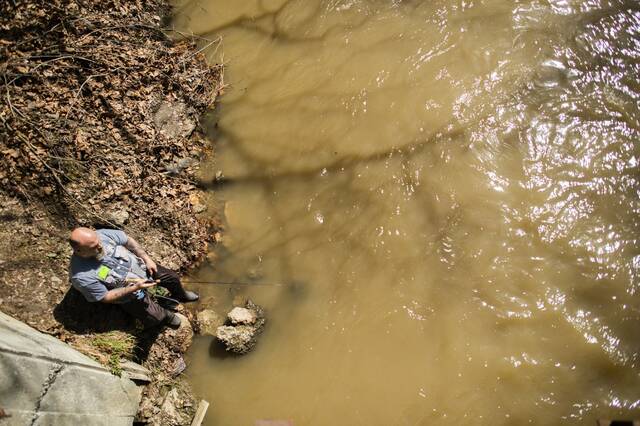Catch 'em while you can: State, local nurseries place more than 4 million trout in waters
Seven out of 10 people who buy an annual fishing license in Pennsylvania also spring for a trout permit.
But most of those anglers probably wouldn’t be able to catch a trout if not for the state’s long-running, $10 million stocking program, which sees millions of trout put into creeks and lakes, where they are but temporary residents.
“Trout fishing as we know it would be almost nonexistent in Pennsylvania without supplementing the waters with stocked trout,” said Mike Parker, a spokesman for the state Fish and Boat Commission. “We have some vibrant populations of wild trout scattered across the state, but, for the most part, those are cold mountain streams and some of them are fully or very difficult to access. Some of them are completely held within private property with no public access.”
Saturday was the opening day of trout season and Parker said April and May are the best time to catch trout, as they’re not intended, or able, to survive for long.
The stocking program, funded primarily through the sale of fishing licenses and permits and boat registration fees, sees trout put into streams and lakes open to public fishing.
There are 14 fish hatcheries across the state, with eight of them almost exclusively producing trout — rainbow, brown, brook and golden rainbow.
About 3.2 million trout come from the state’s hatcheries each year. Another 1 million come from cooperative nurseries run by sportsmen’s groups and local angler associations, which raise fingerling trout they get from the state.
“What we’re doing is taking these trout and bringing them to your neighborhood, to your county and places they would not otherwise exist,” Parker said. “For a short period of time, there is a recreational opportunity there that is not only fun, enjoyable and a great way to spend time outdoors, it’s also a great economic booster. Every community that has a stock trout stream or lake within it benefits from the opening day buzz and tourism provided to those areas.”
And while folks like Parker are stocking streams, others like Dan McMaster are stocking shelves that cater to fishing and hunting enthusiasts.
“Over the last month or so, our fishing business starts to really pick up,” said McMaster, who works at Ligonier Outfitters on the town’s Main Street. “We have a store full of fly-fishing supplies. We try to make sure we have enough help on hand and we’re usually in good shape.”
Jason Kindzia, co-owner of Ultimate Outdoors on the Plum-Murrysville border, said fishing business “really explodes” this time of year as opening day for trout gets closer.
“What’s unique for us is we stock a lot of live bait and fishing supplies,” Kindzia said. “It’s a busy week for us.”
According to the American Sport Fishing Association, with which Parker said the state works closely, the annual economic impact from recreational fishing in Pennsylvania is at least $627 million, with about 70% of that attributable to trout fishing.
But Parker said that picture is incomplete, as it does not take into account anglers buying meals, lodging or gas from local businesses. It also does not include children, as licenses are not required for those under 16.
A common misconception is that trout are stocked to establish new populations in the state. That’s not the case, Parker said.
“It is a put-and-take fishery. We put them in. We want you to take them out,” he said. “These hatchery-raised fish are stocked into waters that, in the vast majority of cases, would not even be capable of supporting a wild trout population because the water is too warm for a good portion of the year. We’re putting them in in the spring when the water is still cold.”
The brook trout is the only species native to the state, Parker said. There are wild populations of brown trout as well.
While the others are nonnative, they are not considered invasive or harmful to the ecosystem, he said. Still, the state does not put trout into waters with any significant populations of wild brook or brown trout.
The trout are usually in the water for just a few days or a few weeks before they are caught. By mid-June, the water becomes too warm for trout. Those that aren’t caught and don’t find a deep portion of a lake or a cold part of a stream will succumb to natural pressures or become prey for birds or other animals capable of catching them.
“The opening day of trout season is an opening day of a season that lasts about two months,” Parker said. “If you go back looking for these fish in a stream in August, they’re not going to be there.”
Kindzia doesn’t do as much fishing as he’d like these days.
“We have limited time to fish anymore,” he said. “But I really liked Loyalhanna Creek out toward Latrobe and Ligonier, and I’ve done a lot of fishing at Deer Creek up near Tarentum.”
Brian C. Rittmeyer is a TribLive reporter covering news in New Kensington, Arnold and Plum. A Pittsburgh native and graduate of Penn State University's Schreyer Honors College, Brian has been with the Trib since December 2000. He can be reached at brittmeyer@triblive.com.
Remove the ads from your TribLIVE reading experience but still support the journalists who create the content with TribLIVE Ad-Free.






